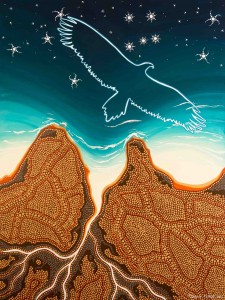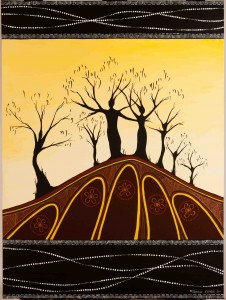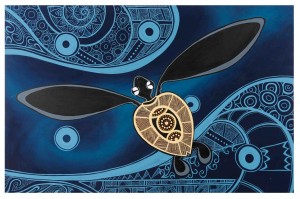The sun is beating down from its midday perch, but the umbrella above Safina Stewart’s market stall is keeping her cool. In front of her are stories, ones about animals and trees, big blue skies and track-marks, bravery, wisdom, community and hope. Mostly, they relate to Safina’s favourite story of all time—“the Jesus story”. Written in brushstrokes with bright, clean and smooth lines, these stories speak of a creative instinct given by a creative God. An artist selling her paintings to a steady flow of strangers, Safina is eager to tell her stories.
A man comes towards her stall and Safina recoils when she sees him coming. “He looks as rough as nails,” she thinks. A skinhead with a beard that waterfalls down to his waist, a leather jacket decorated with skulls and his body an ink explosion, she sees by his side a wild dog, a dingo on a leash. The bikie picks up a painting of an eagle in flight and looks at Safina. She explains to him its meaning, about how in Wurundjuri country, the eagle, Bunjil, is the symbol given to the creator of all things. “Did you know that the creator of all things created you and has a purpose and a plan for your life? He is like the eagle, and is always present, hovering and watching over you. He knows everything about you and loves you so much,” she says. The bikie listens closely and begins to cry. He buys the artwork, and Safina is left praising God.
“I’m always praying. Before I do a market, I say, ‘Lord bring the people who need to hear of your love.’ And you always know the people who come, it’s not by accident,” Safina tells me.
A mother of two living on the edge of Melbourne in the Yarra Ranges, Safina Stewart (nee Fergie) grew up in Papua New Guinea until she was 13, but her roots lie on other islands: three in fact.
“Dad has Scottish heritage, Mum has Indigenous heritage. Mum was born on Thursday Island and her Aboriginal heritage is Wuthathi country – Shelburne Bay on eastside of Cape York,” she explains.
It wasn’t until Safina was a teenager back in Australia that she started looking into her Indigenous heritage and last year, she visited her home lands of Shelburne Bay and Thursday Island for the first time. Exploring the warm coastal environments, Safina was struck by how similar it felt to Papua New Guinea.
“All of a sudden I realised that God never took me too far from where home was,” she says. “And all that time I was home because I was home with him. He is home. But stepping onto my country, I can’t explain it except to say I felt at home there. I reckon nothing will top it until I go to heaven, till Jesus takes me home.”
Safina comes from an artistic family, but she didn’t start painting deliberately until 2007, when she began selling her work and using it to reach people with the good news of Jesus. On the back of every painting, Safina writes the story behind the picture, often pointing to her faith, because she’s convicted Aboriginal art is an extremely effective way of sharing the gospel, both with non-Indigenous and Indigenous people.
“The best thing about Indigenous art is the ancient stories that are told and how they’re delivered—everything had a meaning or a story to it—and so I use that as a vehicle to communicate stories.”
Safina’s work will be featured in a book of Aboriginal art depicting Bible stories which is being published by Bible Society Australia. The book will demonstrate the depth of spirituality among Aboriginal Christians while showcasing their artistic talent and reaching people with the gospel.
Bible Society’s Remote and Indigenous ministry team is on the hunt for Aboriginal Christian artists from across Australia’s urban and outback regions to contribute work.
Safina believes the book has great potential as an evangelistic tool.
“It’s aiming to explore and share Jesus’ love and it’s doing it through the mechanism of story and symbolism that connects with my Indigenous people group. It will be very powerful. I’ve seen how powerful it is to tell stories to people who have no idea about Jesus and Indigenous culture.
“For the Indigenous people, it’s talking our language… It’s a respectful way of sharing the gospel. That’s very important because it resists the notion of Christianity equals losing our culture—it’s the opposite. It’s saying Christianity can redeem our people and allow for our cultural practices to be honoured and to be highlighted.
“So whether the audience is Indigenous or non-Indigenous or national or international it’s going to be a new opening doorway to good relationship.”
To have your work considered for the book or to receive more information, email here. To see more of Safina’s work, go here or to see a video of her producing a recent work, watch this.
Email This Story
Why not send this to a friend?




